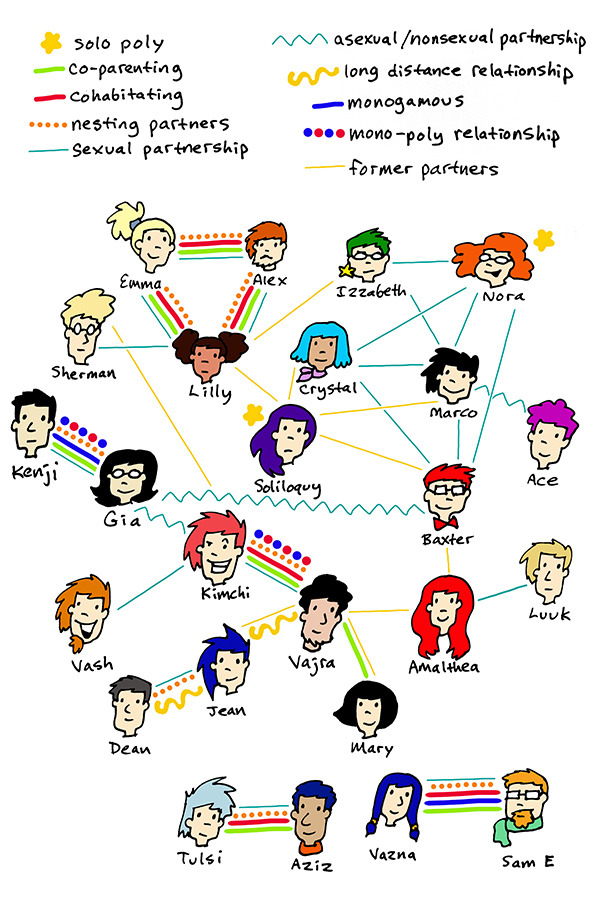If you are at the centre of things… – …you might get in anybody’s way
[Hinges and wings – Part 1]
I could perhaps even rhyme a little pointedly:
“No matter how small the polycule, one must be the centre as a rule…”.
Polycule?
Centre?
And what or who is “anybody” then?

The word “polycule” first appeared in polyamorous usage in 2007, when someone noticed that many multiple relationship structures – especially when drawn to illustrate these network-like connections, for example – shared a certain resemblance to molecules. The metaphor is exceedingly apt in that both molecules and polyamorous relationships with multiple participants can produce small, large, long-chained, compact, or even rather cyclic compounds.
In this sense, some of these connections also have no real “centre” (…who or what would be the “centre” of, say, four people…?) – and yet… I’ll get to that in a moment.

The wonderful and fascinating thing about Poly– and likewise Oligoamory is that there actually doesn’t exist a “master blueprint” for a relationship configuration. Each participating person would be – to stay with the picture – quasi an atom with any number of free slots for potential further connections.
All right, in Entry 12 I already described for my Oligoamory in a somewhat limiting way why I personally believe that this wouldn’t be an “infinite” or “arbitrary” number of free positions.
Polycules can thus emerge in different ways. The simplest (and in my life experience most frequent) way is, if there exists somewhere a person, who one day feels love for two other persons at the same time – and already a first mini-polycule with “central atom” and V-shaped connection to two other “atoms” is created. Those two “other atoms” do not necessarily have to enter into a relationship with each other, so that a kind of “triangle” would be created. But for successful Polyamory it would be favourable in the medium term if there were nevertheless some kind of “interaction” between these two “V-atoms”, which I usually like to describe as “general goodwill” or “acceptance”.
Sometimes, however, group constellations are formed surprisingly by the fact that several people suddenly like each other at the same time – so threesomes, foursomes or even larger core groups can develop in which virtually all participants have some form of bond with everyone – but this is more and more improbable with increasing size of a group.
Not at all improbable, however, is the possibility that at some point people who are already part of their own multiple partnership will become involved with another person who in turn is part of a different multiple partnership. Should the fascination for the other participants in the already existing groups of origin now leap over to each other through this connection, it could be that the polycules will connect more closely via further interpersonal connections – the path to some first “cyclic” structures would have been initiated…
As pretty and confusing (that’s why it’s really better to draw something like this in detail on the paper napkin of an overly curious cousin…) all this is and can be – I just wanted to point this out today as an introduction.
Because to simplify, one now might argue that in the world of multiple relationships there are actually only two states for an “atom” – either a person is currently part of several relationships and thus somewhere “in the middle” – or s*he currently has only one relationship with just one other person and is thus, so to speak, “at a side”.
This is equally recognized among poly- and oligoamorically involved people – in the Anglo-American languages there are already distinct terms for these positions: People who are currently connected to only one person who him*herself has several relationships are called “wing”; those who are currently connected to several other people are called “hinge” or “pivot”[because their position resembles a furniture- or a door-hinge that allows at least two other parts to move around it].
To make it more complicated, “hinge partners” can of course also be “wing partners” at the same time, if their partners are in turn in relationships with other persons; relationships in which they themselves accordingly would only be a “wing”…
And with this additional complication, we would finally arrive at my topic for today.
For even if we were to draw up our multiple relationships – as extensive or as small as they may be – a clear assignment of who would be “wing” or “pivot” would only exist on paper.
Besides, one might reproach me immediately, why this should be an “oligoamorous” topic at all, since I would write here incessantly about intimate connections with literally “few” participants – surely there wouldn’t be so many “sides” or “centres” anyway?
Real life, however, is manifold…
From the outside – especially from people who do not live polyamorous – the “central position” seems to be perceived predominantly as a manifested dream: In the middle, appreciated, desired and pampered from several sides, the centre of attention and already thereby enjoying numerous benefits…
In contrast, the majority of polyamorous guidebooks often dedicate at least one whole chapter to this notable “centre position” – usually with many recommendations and hints on how to manage the challenges encountered there reasonably well.
Indeed, multiple relationships often reflect the clash of many different needs. Where will this tension be greatest in the event of conflict? Probably at the centre… And immediately it is the ” pivot ” – around which everything seemed to revolve benevolently just a moment ago – at which the greatest centrifugal forces now occur, because various desires and/or requirements pull in different directions.
In my opinion, however, this very common example already shows that in a multi-person configuration the “centre” which has been classified in such detail above is not specified at all. Because the impression, as far as the needs of others involved in the relationship are concerned, of “feeling the weight of the world (only) on your own shoulders”, may catch you in any position – at the side or at the centre.
Just when, for example, exactly this phenomenon of the “negative centre” arises – virtually as if you yourself were the lowest point of some event in the relationship, on which now the full load is coming down from all sides – it is favourable to pause and ask yourself whether you are actually really “the centre” in this capacity.
For one does not need to be poly- or oligoamorous in order to “feel the weight of the world on one’s shoulders”. Because in many cases this impression already arises when we declare ourselves responsible for things that are not ours at all when viewed from a different angle.
Or in a relationship: which are not ours alone.
Especially in ethical multiple relationships, I see here a certain danger of “over-fulfillment” by which one does a disservice to oneself and to others. I’ve written about commitment and accountability in numerous entries here, so it could quickly seem as if the overall weal and woe of a relationship is hanging like a millstone around the neck of each and every person involved. And that in this sense the “weak link” (or atom…) of a multiple relationship in the case of failure would have to answer for the collapse of the whole with the own insufficiency, of having not tried hard enough.
But this is not how Oligoamory is meant. A mutual relationship and a mutual well-being need a mutual responsibility. And this has always to be supported by all involved – no matter if currently “centre” or “wing”.
How vague the assignment of a “defined centre” of a relationship is, is very often also shown by the popular example of the so often practised “triangular communication”. It doesn’t take just three people (it can easily be more) – and in the vernacular it is simply referred to as “talking about…”. The lure of such a failed conversation culture has become even greater since the age of social networks and messenger services.
Of course, it is probably most human to talk “about each other” even within a relationship. And since hopefully our relationship partners are also our closest confidants, to whom we literally want to “entrust” ourselves with all our daily needs, it is also understandable if we see them as our “allies” and to a certain extent also as our counsellors. Through indirect triangular communication, however, we very quickly play off one of our allies against another within close relationship networks – and that can’t work out well.
The Polyamory-bLog “Mehrfachzucker” ¹ (Original source only in German) adds:
»Taking the conflict to another person will most likely, on top of everything else, damage the relationship between the third person and the person who is actually the issue. The actual conflict is not solved, but outsourced and often even intensified. In addition, the partners of our partners also have a right to their own privacy. So agree beforehand what is allowed to be passed on and what is not.
Triangular communication is treacherous and leads to numerous problems. Shifting responsibilities, creating new conflicts and violated trust are just a few examples. Triangular communication happens quickly and insidiously at the same time.«
The latter means: How quickly is something typed emotionally into the mobile phone and shared with a third party out of a situation, which is still being discussed controversially at the table. In this way, we turn our other favourite people into “captives”, with whom our only concern is to get them as quickly as possible into our “own camp” as supporters…
A similarly unpleasant side-centre-side variant of triangular communication is, by the way, also the playing off of one’s own partners or partners of partners against each other: “XYZ has caused me to act in such and such a way…”. In this way, people like to avoid responsibility for their own decisions by shifting the causality to someone else in the wider relationship. One “wasn’t no longer able” to act in any other way, so to speak. Unfortunately, I have already caught myself arguing in such an unbearable way, especially in order to justify to myself the imprudence of some actions. For our favourite people such a shift of responsibility must be even more insufferable to endure.
To one of the most delicate phenomena in my eyes, the authors Franklin Veaux and Eve Rickert have dedicated the following text in their basic book “More Than Two” ² – it describes what happens when “wings” and “hinges” begin unyieldingly to offset against own claims:
»”That’s not fair!” Below a certain age, we hear people say this all the time. Past that age our vision gets longer, an d we learn that fairness operates best on a global, not a local scale. If you did the dishes last night and it’s your sister’s turn tonight, but she isn’t doing the dishes because she just got back from dental surgery, it may seem unfair to you from a purely selfish perspective… but really, would you want to trade places with her? And if you were the one who’d just been through the root canal, wouldn’t you appreciate a pass on the dishes tonight? Sometimes compassion dictates that a rigid schedule should change.
By the time we’re adults, we’ve pretty much figured this out. That, or we’ve just given in to exhaustion and stopped worrying so much about what’s “fair” on such a granular level. Yet in relationships, especially in polyamorous relationships, the little whisperings of our five-year-old selves poke through and say, “That’s not fair!” when things don’t get the way we expect. Even when we don’t talk about our expectations. Even when we know our expectations are silly. When you’re balancing more than one partner, you will surely hear this sentiment. The words may change, but the meaning is predictably constant: “That’s not fair!”
In dealing with human beings, issues of “fairness” sometimes need to go right out of the window. People change and needs change, but often our notions about what is “fair” remain static, so deeply buried that we’re not even aware of them [“Inner Highways” in Jealousy-Entry 36]. The fairness that is important in relationships isn’t the tit-for-tat. In fact, sometimes a tit-for-tat approach to fairness creates a situation that’s decidedly unfair […]: Symmetry is not he same thing as fairness.
The kind of fairness that really counts is the kind that begins with compassion. Fairness means saying things like “I realize that my insecurity belongs to me, so I will not use it as a blunt instrument on you, nor expect you to plot your life around it. I may, however, ask you to talk to me while I’m dealing with it”.
This isn’t the kind of fairness our inner five-year-old understands; he’s far more likely to be worried about someone else getting something that he doesn’t have, or getting something for a lower “price” than he paid for it [Envy-Entry 59]. At the end of the day, though, our mental five-year-old isn’t likely to make our lives better, no matter how much of a fuss he puts up.«
Since our (multiple) relations are therefore just no static structures (see Scott Peck in Entry 8 and in Entry 79), we will recognize ourselves on all “positions” there regularly (also with a small number of participants!): In the middle as “hinge” or “pivot” – or at the side as “wing”. Our human ambivalence furthermore will push us into the middle from time to time of our own accord – and also move us again back to a wing position.
More or less at the same time, we will therefore also often be “pulling” and “pulled”, ” pushing” and ” pushed” in parallel. Just as we are at all times both “enjoyers” and “contributors”, “supported” and “supporters”, “lovers” and “beloved”.
What is important – and in this I agree with F.Veaux and E. Rickert above – that we are therefore continuously prepared at all positions to give our compassion an important, perhaps even the most important voice.
If we succeed in this, we get in each other’s way much less, rather our relationships then become – to say it with the Persian Sufi mystic Rumi – “gardens beyond right and wrong”.
That is where we will meet.
¹ Mehrfachzuckerblog: Dreieckskommunikation – Sich über Ecken im Kreis drehen (only German language available, sorry!)
² Franklin Veaux und Eve Rickert „More Than Two – A practical guide to ethical polyamory“, Thorntree-Press 2014
Thanks to Tikva Wolf (author of the popular Kimchi Cuddles Polyamory comics) and the most personal permission to use the polycule-artwork on my bLog (all rights © by the cartoonist!)
and thanks to Terry Vlisidis on Unsplash for the molecule-photo.

